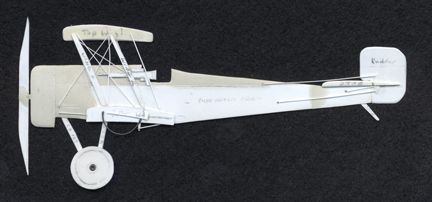This is a project that has been on-again, off-again for the better part of this year. Some recent discussions about flat aircraft prompted me to revive it. The first part of the project involved finding some decent plans/drawings and some photos of the actual aircraft. That took about an hour on the web. Once I found dimensional data, I was able to scale the drawings down to 1/48. I then started comparing drawings to each other and the photos to check for (reasonable) accuracy. Pretty much all of the drawings were in the ballpark, while photos, assuming they were captioned correctly, show that most of the differences centered around the Scout variants - A, B, C, and D. I went with the C because it was used by Capt. (later Major) Lanoe Hawker who was awarded a VC for knocking down three German aircraft in 1915. Hawker eventually became Britain's first ace. More here:
http://en.wikipedia.org/wiki/Lanoe_HawkerThe project seemed simple enough. Once the plans were scaled, I traced the profile outline and various parts onto an assortment of sheet plastic ranging from .010" to .025". The parts were cut out using an X-acto knife and/or scissors. The fuselage from the cowl face to the rudder post is one piece with a second smaller piece laminated over it. The second piece goes from the angled line at the front to another point just in front of the horizontal stabilizer. Putty was added to the upper rear deck to depict the rounded top, while more putty was added to upper front deck, nose side panels and cowl. All were rounded and sanded smooth. The panel lines were engraved. The Scout was built in layers according to plan that was about 90% accurate. There were a few times that I had to backtrack and take something apart in order to fit something in.

For example...
One thing I want to try was rigging. I used very thin music wire (the primered photo shows this), but it looked a bit too thick - even more so when painted. I pulled them off and found some .010" (.3mm) plastic rod and it instead. It look more to scale than the wire, but it's technically too thick. I won't quibble...

Once together, the assemble Scout was primed with Floquil Model Railroad Primer, cut about 20-25% with lacquer thinner and brushed on (sounding like a broken record there...). The airframe is overall Reaper Amber Gold triad (depicted the clear doped linen fabric), while the metal parts are Honed Steel triad. The struts are the Shield Brown triad. The tires are the Stone Gray triad, while the hand-painted markings are Fire Red, True Blue, and Misty Gray (which is almost a dark white; I use Pure white for the highlights). The tail number 1611 was painted with a Stormy Gray and Pure Black mix. The flying and rigging wire were painted Adamantium Black (metallic black) and highlighted with a gunmetal pencil. As a side note all of the triads can be intermixed to create additional hues with the triad and lighted or darkened with other colors as needed. Great idea those triads...

That's it! As always, questions, comments, and feedback are welcomed.
Cheers,
Glen